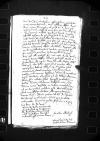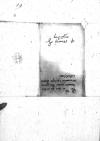Letter #2617
Stanisław HOZJUSZ (HOSIUS) to Ioannes DANTISCUSCracow (Kraków), 1543-01-19
| received Heilsberg (Lidzbark Warmiński), 1543-03-04 Manuscript sources:
Prints:
| ||||||
Text & apparatus & commentary Plain text Text & commentary Text & apparatus
Reverendissimo in Christo Patri et Domino, domino
Reverendissime Domine, domine colendissime.
Officiosissimam servitutis meae commendationem.
Non arbitror adhuc reverendissimum
Nova huc allata sunt. Egressis praedatum e
Deum precor, ut Reverendissimam Dominationem Vestram diu servet incolumem. Cuius me gratiae commendo.
Eiusdem Reverendissimae Dominationis Vestrae servitor addictissimus
Postscript:
Nova de


 AAWO, AB, D. 19, No. 29_2
AAWO, AB, D. 19, No. 29_2